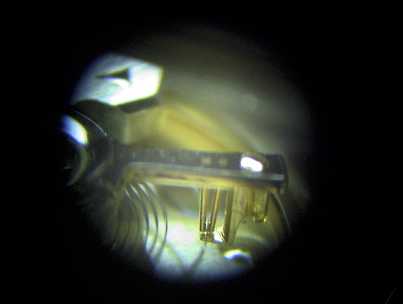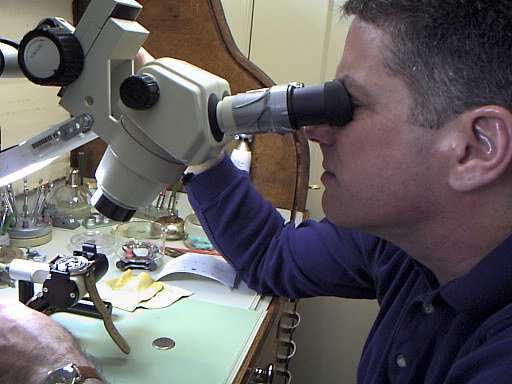
Image of the regulator pins of a Langematic at 35X magnification.
By TC Khoo, 2 Jan 99 Pictures and formatting by Peter Chong

There is very limited amount of information available to a watch collector about what goes into a watch and what has been done to what was put into it. This is intolerable in this Age of Information, but I suspect that this practice has been on going for some reasons. Let us look at some of the possible excuses that may explain the paucity of data:
Obviously, this is changing (slowly), with the greater demand for information by powerful Forums like Time Zone. But, if you are not satisfied with the snail’s pace, why not interrogate the watch manufacture yourself?
How can this be done? You ask.
The solution suggests that you interrogate the watch itself.
Many a time close examination of the final product will reveal more than a manufacturer will divulge in many circumstances.
In Medicine, a classic physical examination begins with Observation or Inspection, followed by Palpation, Percussion and then Auscultation. With the exception of the first (Observation) and third (of course, one does not "percuss" a watch), I have written a short note about the others entitled "Non-Visual Pleasures … The Best and the Worst" (see Bulletin Board # 85). In some subsequent posts to this, Walt A and O and others have added significantly to this thread - especially with regard to the amplified sound characteristics of the escapement complex and its interpretation.
Depending on the disease state, the different phases of examination will reveal different proportions of information leading to a diagnosis. However, in most cases the astute master clinician will derive arguably the most information from inspection. We used to hear claims of these Masters making the diagnoses as the patient walks through the door. Observation, as in the case of Sherlock Holmes, allows the clinician to perform his detective work and that was what fascinated me about Medicine. Of course, nowadays with the advent of all sorts of imaging and tests, truly Clinical Medicine in many cases, has become a lost Art!
As a medical student, I used to use the monocular microscope a lot in Microbiology and then subsequently as well. I am perpetually fascinated by being able to see minute details and microorganisms and also far away places - hence my avid interest in microscopes, macrophotography and telescopic lenses. I have a Leitz Wetzler microscope that my grandfather gave me and it is a beautiful instrument to use.
I really wanted to be able to see what others have seen in movements, and better understand what I see. That together with an ability to appreciate movements to a new depth, was the reason for this purchase.
Yesterday, I acquired a new set of eyes that allow me to look through the windows of crystal backs to the very heart of the movements that I collect. To say that that the last few hours have been a fascinating journey into the anatomy of the watch would be a understatement of enormous proportions.
LOUPES




I had previously relied on loupes for close examinations of watch movements. The one most common types of loupes is the jeweller’s loupe. I have nameless 4X and 10X loupes. Like most of their kind, they are conical black plastic surrounds enclosing the lenses and usually have a 5cm focus. The 4X is a single lens type and is used for general inspection of the watch and its movement. The 10X is used for more detailed examination of critical areas that I want to concentrate on. This loupe looks to be a compound lens set up. They vary between $20-30 and give acceptable viewing.
The problems with loupes are that:
The other type of loupe is usually produced as a photographic accessory. These are generally better quality loupes (once again depending on the manufacturer). Some of these problems mentioned may be corrected by the better manufacturers – usually in loupes made for photographic use by Zeiss (there is also a "Ziess" available in Singapore), Schneider, Nikon, Pentax and some of the more reputable lens makers. These loupes usually are for viewing negatives or slides, as focusing aids for medium format camera screens and usually have a clear cup surround. There are even zoom loupes available (5-10X)! You can use them inverted to examine at watch movements.
These good quality loupes are very costly and run into hundreds of dollars. The corrections take the form of optical quality coated glass using aspherical elements and assembled in compound lens configurations. Whereas some of the technical problems found in cheap loupes are fixed, e.g. some distortions, image viewing area, others cannot. You will not find many decent quality loupes above say 12X viewing magnification because of some of the issues mentioned above that limit the practical use of these loupes.
STEREOSCOPIC MICROSCOPES
|
Beyond loupes, we are talking about Stereoscopic Microscopes. For the totally certifiable watch lunatic, this is THE instrument to use to inspect your watch. And of course, being the originator of Mycroft’s Psychosis, that is exactly what I bought myself on the very first day of the last year of the Millennium! I saw it on the way out of a shop that specialises in Nikon cameras. Its squat blue body sat on a glass shelf tucked away in a corner. I froze for a while – it was what I had been looking for, for a while now – the perfect (for me) instrument to view my watches! It is the Nikon Field Stereo Microscope, otherwise called the Naturescope (apparently nature buffs use it to look at ants and stuff crawling all over the place. But it is perfect for me. It is available for about US$350-400. This Nikon has a fixed 20X image magnification. It is small, portable and at 610g weighs about the same as a rangefinder camera – a little heavier than your regular loupe. It includes lugs and a neck strap to allow you to hang it around your neck as you traipse along during your next Basel trip! The microscope has an independent built-in battery operated halogen light source to augment ambient light should it be inadequate. There is a diopter adjusted binocular eyepiece that allows fine-tuning of inter-pupillary distance as well. All this is housed in a beautiful blue sculpted polycarbonate body that acts as an exoskeleton for its internal aluminium alloy frame (same material used in the nearly indestructible Nikon camera bodies). |  My microscope! |
The most critical part of the assembly is the lens. Here, Nikon uses its famed optical quality lenses. The result is an image quality that is several orders of magnitude better than peering through a loupe.
The beauty of it is that in a stable platform (the stage allows for a tripod mount). With placement of the movement parallel to the lens, you can examine "layers" of the movement through selective focusing - using the depth of field to help you look at the plane you are interested in and blurring out the other areas that you can examine latter. The finely adjustable rack and pinion mechanism (with helical threads), is wonderful to use.
The stage is reversible to either give a flat matt white surface, or a well which you can use to observe the different organisms that may be growing in your watch, should it lose its waterproofing seal when you go for a swim! What will Nikon think of next!!
Having used this instrument to closely examine my watches, the differences in execution of finish is clear as daylight between such giants as Patek and Lange (Lange mirror finishes its anglage – amazing work– Patek does not; even the differences in finish of the anti-shock springs is obviously different between the two!!).
 Walt Odets...seen here on his Nikon zoom microscope. |
Things missing Ideally, I would have loved the microscope to have a zooming capacity and a higher magnification (say 5-35/40X zoom). But the higher magnification is really not necessary and there is a thing called overkill. An accessory port for photomicrography would have also been nice, since this will allow me to record what I see with pictures. These features will really bring you to the next level of microscope – namely the industrial series by Nikon with the SMZ/SMU designation. On the way, the price quadruples at their lowest range, so that is why that choice was out for me. There are obviously more reasonably priced microscopes with similar features, but I did not explore those options. Some excellent references to begin appreciating movements, and a complement to the stereomicroscope are two articles on Time Zone: Walt Odet’s definitive piece on ABCs of Watch Finish and JackFreedman’s Escape Wheeling pictorial piece on The Beauty of Watch Decorations and Finishes. Now, you can finally see what they are talking about! |
Perhaps a good quick and dirty summary would be to look at the microscope’s advantages and disadvantages:
|
Advantages | Disadvantages |
|
|
It is clear that the pluses far outweigh the negative. It is an important tool that allows us to advance in our appreciation of the quality and finish of watches.
So how do you interrogate your watch manufacture? With a good instrument that allows you to see what they have done (or not done) to your watch – THAT, is the secret.

And accessed
times since.